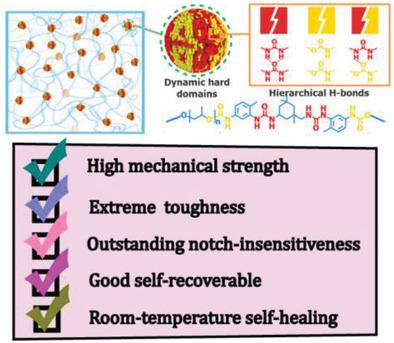当前位置:
X-MOL 学术
›
Adv. Funct. Mater.
›
论文详情
Our official English website, www.x-mol.net, welcomes your feedback! (Note: you will need to create a separate account there.)
Transparent, Mechanically Strong, Extremely Tough, Self‐Recoverable, Healable Supramolecular Elastomers Facilely Fabricated via Dynamic Hard Domains Design for Multifunctional Applications
Advanced Functional Materials ( IF 19.0 ) Pub Date : 2019-10-22 , DOI: 10.1002/adfm.201907109 Dong Wang 1 , JianHua Xu 1 , JiaoYang Chen 1 , Po Hu 1 , Yang Wang 1 , Wei Jiang 2 , JiaJun Fu 1
Advanced Functional Materials ( IF 19.0 ) Pub Date : 2019-10-22 , DOI: 10.1002/adfm.201907109 Dong Wang 1 , JianHua Xu 1 , JiaoYang Chen 1 , Po Hu 1 , Yang Wang 1 , Wei Jiang 2 , JiaJun Fu 1
Affiliation

|
The design and synthesis of supramolecular self‐healing polymers with high healing efficiency and excellent integrated mechanical properties is challenging due to conflicting attributes of dynamic self‐healing and mechanical properties. Herein, this study introduces a design concept, that is, “dynamic hard domains,” to balance self‐healing performance, mechanical strength, elastic recovery, and at the same time obtain extreme toughness. The essential features of the dynamic hard domains include: (i) a noncrystallized and loose structure, (ii) low binding energy and high mobility, and (iii) sequential dissociation and rapid rearrangement. Based on this strategy, a simple one‐step polycondensation route is reported to synthesize a transparent polyurethane‐urea supramolecular elastomer (PPGTD‐IDA), which successfully combines decent mechanical strength, extreme toughness, outstanding notch‐sensitiveness, self‐recoverability, and room‐temperature self‐healing. Upon rupture, the PPGTD‐IDA completely restores the mechanical properties within 48 h. Furthermore, the results demonstrate repeatable healing of mechanical properties and prominent antiaging healability. Taking advantages of merits of PPGTD‐IDA, it can be utilized for fabricating impact‐resistant materials for protection of aluminum alloys as well as stretchable and self‐healing conductors, which exhibits unique characteristics such as stable conductivity during stretching (even after healing or with notch), and automatic elimination of the notch during stretching/releasing cycles.
中文翻译:

通过动态硬域设计方便地制造的透明,机械强度高,韧性极强,可自我恢复,可修复的超分子弹性体,可用于多功能应用
由于动态自愈和力学性能的相互矛盾,具有高愈合效率和优异的综合机械性能的超分子自愈聚合物的设计和合成面临挑战。在此,本研究引入了一种设计概念,即“动态硬域”,以平衡自我修复性能,机械强度,弹性恢复并同时获得极高的韧性。动态硬结构域的基本特征包括:(i)非结晶且疏松的结构,(ii)低结合能和高迁移率,以及(iii)顺序解离和快速重排。根据这种策略,据报道,一种简单的一步缩聚路线可合成透明的聚氨酯-脲超分子弹性体(PPGTD-IDA),它成功地结合了体面的机械强度,极高的韧性,出色的缺口敏感性,自我恢复能力和室温自我修复能力。断裂后,PPTGD-IDA会在48小时内完全恢复机械性能。此外,结果证明了机械性能的可重复愈合和显着的抗衰老可治愈性。利用PPGTD-IDA的优点,它可用于制造耐冲击材料,以保护铝合金以及可拉伸和自愈的导体,并具有独特的特性,例如在拉伸过程中具有稳定的导电性(即使在修复后或经修复)。刻痕),并在拉伸/释放周期中自动消除刻痕。和室温下自我修复。断裂后,PPTGD-IDA会在48小时内完全恢复机械性能。此外,结果证明了机械性能的可重复愈合和显着的抗衰老可治愈性。利用PPGTD-IDA的优点,它可用于制造耐冲击材料,以保护铝合金以及可拉伸和自愈的导体,并具有独特的特性,例如在拉伸过程中具有稳定的导电性(即使在修复后或经修复)。刻痕),并在拉伸/释放周期中自动消除刻痕。和室温下自我修复。断裂后,PPTGD-IDA会在48小时内完全恢复机械性能。此外,结果证明了机械性能的可重复愈合和显着的抗衰老可治愈性。利用PPGTD-IDA的优点,它可用于制造耐冲击材料,以保护铝合金以及可拉伸和自愈的导体,并具有独特的特性,例如在拉伸过程中具有稳定的导电性(即使在修复后或经修复)。刻痕),并在拉伸/释放周期中自动消除刻痕。
更新日期:2020-01-17
中文翻译:

通过动态硬域设计方便地制造的透明,机械强度高,韧性极强,可自我恢复,可修复的超分子弹性体,可用于多功能应用
由于动态自愈和力学性能的相互矛盾,具有高愈合效率和优异的综合机械性能的超分子自愈聚合物的设计和合成面临挑战。在此,本研究引入了一种设计概念,即“动态硬域”,以平衡自我修复性能,机械强度,弹性恢复并同时获得极高的韧性。动态硬结构域的基本特征包括:(i)非结晶且疏松的结构,(ii)低结合能和高迁移率,以及(iii)顺序解离和快速重排。根据这种策略,据报道,一种简单的一步缩聚路线可合成透明的聚氨酯-脲超分子弹性体(PPGTD-IDA),它成功地结合了体面的机械强度,极高的韧性,出色的缺口敏感性,自我恢复能力和室温自我修复能力。断裂后,PPTGD-IDA会在48小时内完全恢复机械性能。此外,结果证明了机械性能的可重复愈合和显着的抗衰老可治愈性。利用PPGTD-IDA的优点,它可用于制造耐冲击材料,以保护铝合金以及可拉伸和自愈的导体,并具有独特的特性,例如在拉伸过程中具有稳定的导电性(即使在修复后或经修复)。刻痕),并在拉伸/释放周期中自动消除刻痕。和室温下自我修复。断裂后,PPTGD-IDA会在48小时内完全恢复机械性能。此外,结果证明了机械性能的可重复愈合和显着的抗衰老可治愈性。利用PPGTD-IDA的优点,它可用于制造耐冲击材料,以保护铝合金以及可拉伸和自愈的导体,并具有独特的特性,例如在拉伸过程中具有稳定的导电性(即使在修复后或经修复)。刻痕),并在拉伸/释放周期中自动消除刻痕。和室温下自我修复。断裂后,PPTGD-IDA会在48小时内完全恢复机械性能。此外,结果证明了机械性能的可重复愈合和显着的抗衰老可治愈性。利用PPGTD-IDA的优点,它可用于制造耐冲击材料,以保护铝合金以及可拉伸和自愈的导体,并具有独特的特性,例如在拉伸过程中具有稳定的导电性(即使在修复后或经修复)。刻痕),并在拉伸/释放周期中自动消除刻痕。


























 京公网安备 11010802027423号
京公网安备 11010802027423号